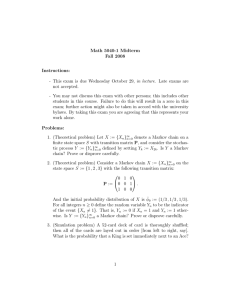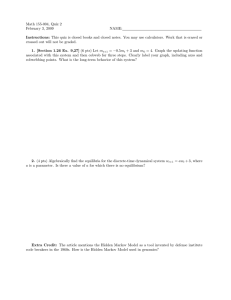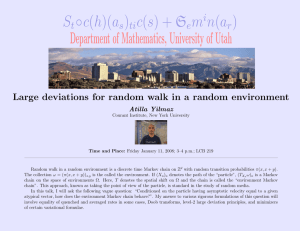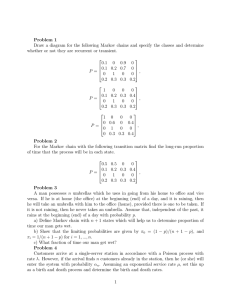Document 13377836
advertisement
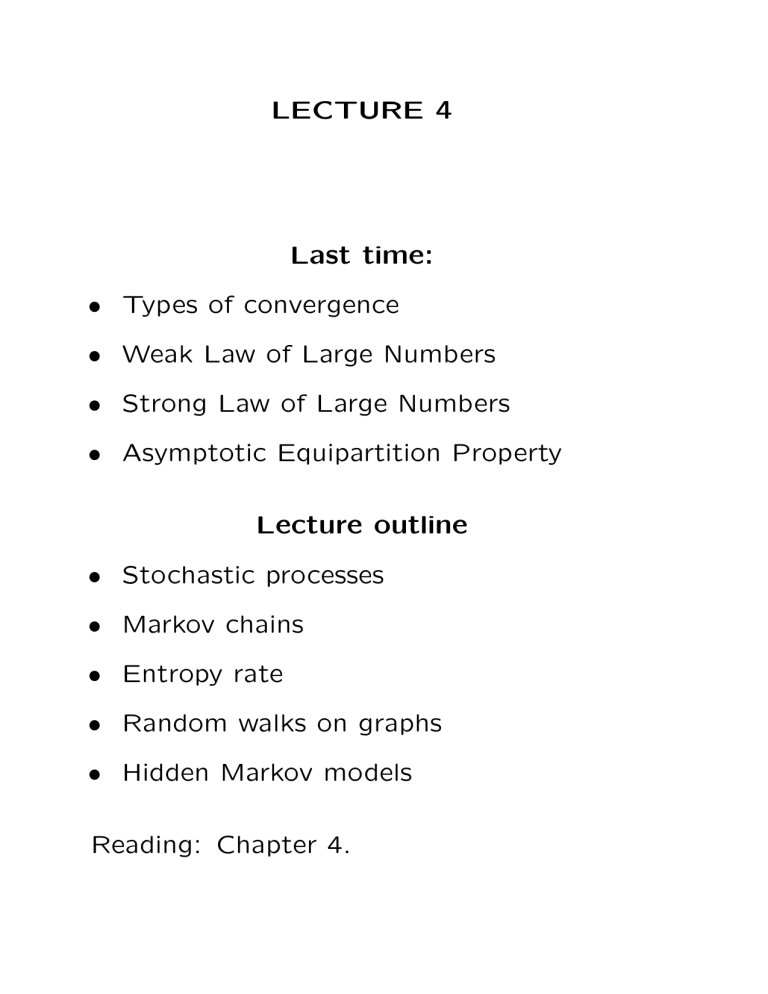
LECTURE 4
Last time:
• Types of convergence
• Weak Law of Large Numbers
• Strong Law of Large Numbers
• Asymptotic Equipartition Property
Lecture outline
• Stochastic processes
• Markov chains
• Entropy rate
• Random walks on graphs
• Hidden Markov models
Reading: Chapter 4.
Stochastic processes
A stochastic process is an indexed sequence
or r.v.s X0, X1, . . . characterized by the joint
PMF PX0,X1,...,Xn (x0, x1, . . . , xn), (x0, x1, . . . , xn) ∈
X n for n = 0, 1, . . ..
A stochastic process is stationary if
PX0,X1,...,Xn (x0, x1, . . . , xn)
= PXl ,Xl+1,...,Xl+n (x0, x1, . . . , xn)
for every shift l and all (x0, x1, . . . , xn) ∈ X n.
Stochastic processes
A discrete stochastic process is a Markov
chain if
�
�
�
PXn|X0,...,Xn−1 xn|x0, . . . , xn−1 = PXn|Xn−1 xn|xn−1
for n = 1, 2, . . . and all (x0, x1, . . . , xn) ∈ X n.
We deal with time invariant Markov chains
Xn: state after n transitions
– belongs to a finite set, e.g., {1, . . . , m}
– X0 is either given or random
(given current state, the past does not mat­
ter)
pi,j = P(Xn+1 = j | Xn = i)
= P(Xn+1 = j | Xn = i, Xn−1, . . . , X0)
Markov chain is characterized by probability
transition matrix P = [pi,j ]
�
Review of Markov chains
State occupancy probabilities, given initial
state i:
ri,j (n) = P(Xn = j | X0 = i)
Key recursion:
m
�
ri,j (n) =
ri,k (n − 1)pk,j
k=1
With random initial state:
P(Xn = j) =
m
�
P(X0 = i)ri,j (n)
i=1
Does rij converge to something?
Does the limit depend on initial state?
Review of Markov chains
Recurrent and transient states.
State i is recurrent if: starting from i, and
from wherever you can go, there is a way
of returning to i. If not recurrent, called
transient. Recurrent class collection of re­
current states that “communicate” to each
other and to no other state.
A recurrent state is periodic if: there is an
integer d > 1 such that ri,i(k) = 0 when k
is not an integer multiple of d
Assume a single class of recurrent states,
aperiodic. Then,
lim r (n)
n→∞ i,j
= πj
where πj does not depend on the initial
conditions
lim P(Xn = j | X0) = πj
n→∞
• π1, . . . , πm can be found as the unique
solution of the balance equations
πj =
�
πk pk,j
k
together with
�
j
πj = 1
Entropy rate
The entropy rate of a stochastic process is
1
H(X n)
n→∞ n
lim
if it exists
For a stationary stochastic process, the en­
tropy rate exists and is equal to
lim H(Xn|X n−1)
n→∞
since conditioning decreases entropy and by
stationarity, it holds that
H(Xn+1|X n) ≤ H(Xn+1|X n
2)
= H(Xn|X n−1)
so it reaches a limit (decreasing non-negative
sequence)
Chain rule
n
1
1 �
n
H(X ) =
H(Xi|X i−1)
n
n i=1
since the elements in the sum on the RHS
reach a limit, that is the limit of the LHS
Entropy rate
Markov chain entropy rate:
lim H(Xn|X n−1)
n→∞
=
lim H(Xn|Xn−1)
n→∞
= H(X2|X1)
= −
�
i,j
pi,j πi log(pi,j )
Random walk on graph
Consider undirected graph G = (N , E, W)
where N , E, W are the nodes, edges and
weights. With each edge there is an as­
sociated edge weight Wi,j
Wi,j = Wj,i
�
Wi =
Wi,j
W =
2W =
j
�
i,j:j>i
�
Wi
i
Wi,j
Random walk on graph
We call a random walk the Markov chain in
which the states are the nodes of the graph
Wi,j
pi,j =
Wi
Wi
πi =
2W
�
Check: i πi = 1 and
�
πipi,j =
i
=
� Wi Wi,j
i 2W
� Wi,j
i
2W
Wj
=
2W
= πj
Wi
Random walk on graph
H(X2|X1)
= −
�
i
�
πi
�
pi,j log(pi,j )
j
�
Wi,j
Wi � Wi,j
= −
log
Wi
i 2W j Wi
�
�
� Wi,j
Wi,j
= −
log
2W
Wi
i,j
� Wi,j
�
�
�
�
Wi,j
= −
log
2W
2W
i,j
�
�
� Wi,j
Wi
+
log
2W
2W
i,j
� Wi,j
Wi,j
= −
log
2W
2W
i,j
�
� Wi
�
Wi
+
log
2W
2W
i
�
Entropy rate is difference of two entropies
Note: time reversibility for Markov chain
that can be represented as random walk
on undirected weighted graph
Hidden Markov models
Consider an ALOHA wireless model
M users sharing the same radio channel to
transmit packets to a base station
During each time slot, a packet arrives to
a user’s queue with probability p, indepen­
dently of the other M − 1 users
Also, at the beginning of each time slot, if
a user has at least one packet in its queue,
it will transmit a packet with probability q,
independently of all other users
If two packets collide at the receiver, they
are not successfully transmitted and remain
in their respective queues
Hidden Markov models
Let Xi = (N [1]i, N [2]i, . . . , N [M]�) denote
the random vector at time i where N [m]i is
the number of packets that are in user m’s
queue at time i. Xi is a Markov chain.
Consider the random vector Yi = (Z[1], Z[2], . . . , Z[M])
where Z[m]i = 1 if user m transmits during
time slot i and Z[i] = 0 otherwise
Is Yi Markov?
Hidden Markov processes
Let Xi, X2, . . . be a stationary Markov chain
and let Yi = φ(Xi) be a process, each term
of which is a function of the corresponding
state in the Markov chain
Y1, Y2, . . . form a hidden Markov chain, which
is not always a Markov chain, but is still
stationary
What is its entropy rate?
Hidden Markov processes
We suspect that the effect of initial infor­
mation should decay
H(Yn|Y n−1)−H(Yn|Y n−1, X1) = I(X1; Yn|Y n−1)
should go to 0
Indeed,
lim I (X1
n→∞
;Y n
lim
) = n→∞
=
n
�
�
I X1
; Y i|Y i−1
�
i=1
∞
�
�
�
i
i−1
I X1; Y |Y
i=1
since we have an infinite sum in which the
terms are non-negative and which is upper
bounded by H(X1), the terms must tend
to 0
MIT OpenCourseWare
http://ocw.mit.edu
6.441 Information Theory
Spring 2010
For information about citing these materials or our Terms of Use, visit: http://ocw.mit.edu/terms.


